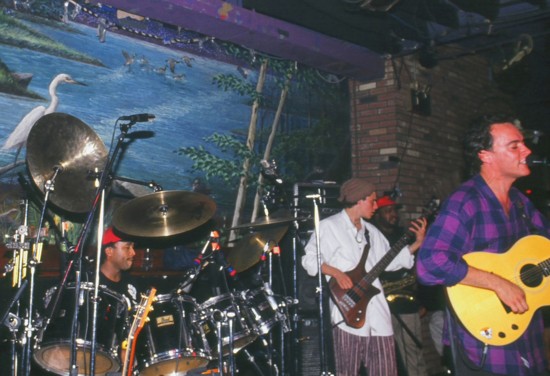FILM-FORWARD.COMReviews of Recent Independent, Foreign, & Documentary Films in Theaters and DVD/Home Video
Directed by Dean Budnick Produced by Peter Shapiro Director of Photography & Edited by Jonathan Healey Released by First Run Features USA. 96 min. Not Rated New York City has boasted many legendary nightclubs closely identified with particular music styles, from the Cotton Club of the Harlem Renaissance to punk rock at CBGB. The downtown club Wetlands Preserve was a key outlet for the politically-conscious interplay of Americana rock, folk, and hip-hop that appealed to open-minded followers of the Grateful Dead when such music had little radio play (and still sneered at by such nightlife mavens as the Village Voice’s Michael Musto in an amusingly ironic interview). Director Dean Budnick traces the club’s chronological history from 1989 to 2001, where he spent many of his college student nights. It was the kind of place where a key question at a job interview would be “When is Jerry Garcia’s birthday?” While providing a launching pad for local bands like the Spin Doctors and Blues Traveler, the club became even more of an important musical focal point after Garcia’s death in 1995, when bereft Deadheads regrouped to keep the vibe going with such bands as Phish and the Dave Matthews Band, whose members are among many performers interviewed. The Dead are raised in an interview with Bob Weir and a clip of an emotional closing performance by Robert Hunter right after 9/11. While there is otherwise surprisingly little actual film footage of acts performing at the club (these were the days before the ubiquitous camera phone), the centerpiece is 15 pulsating music videos by 12 different animators, colored in Yellow Submarine-like psychedelia and mimicking Terry Gilliam's fanciful style from Monty Python's Flying Circus, setting archival photographs and other images to soundboard recordings of young performers who have gone on to much larger venues, including Pearl Jam, Joan Osborne, and Ben Harper. Urban historian Ken Jackson provides background on the changes in the club’s Tribeca neighborhood, from its industrial roots to residential gentrification, which contributed to the venue’s rise and fall. But only towards the end of the film do any interviewees provide the corresponding musical context for non-dedicated fans by defining jam bands (or “hippie bands” as one ex-staffer describes them) and their style as improvisational rock music with long numbers for dancing. Some of the artists interviewed are leading lights of the genre that only the cognoscenti will probably recognize, such as Mike Doughty, from Soul Coughing, and Warren Haynes of the Allman Brothers Band. The film also focuses on club founder Larry Bloch’s original vision of an equally important environmental education and activist component, variously named over the years as an “Eco-Saloon” and then the Center for Social and Environmental Justice. The media attention-getting political demonstrations were themselves performance art, caught on film, including red-painted fur coats proffered in front of Macy’s and reenactments of clubbed baby seals. But it’s hard to be a saint in the city. The environmentally-conscious cleaning and extermination materials Bloch insisted on using are amusingly shown not to be effective at keeping out the roaches and rats endemic to a neighborhood built on landfill.
Budnick stresses the variety of weekend and greet-the-dawn music that drew in a range of ages and fans, from hardcore metal to neo-soul like
Jill Scott and the hip-hop fusion of Fishbone, but black-and-white film of a very young Ani DiFranco from her punk-looking days is the only
recognition of the acoustic politically-oriented singer/songwriters who played the club at weeknight early shows. The very brief interview with pedal
steel guitarist Robert Randolph doesn’t mention that his acclaimed debut disc was a live set recorded there, though one of the film’s themes is the importance
of hearing these bands live. But Budnick entertainingly builds a convincing case for the club’s significance.
Nora Lee Mandel
|
